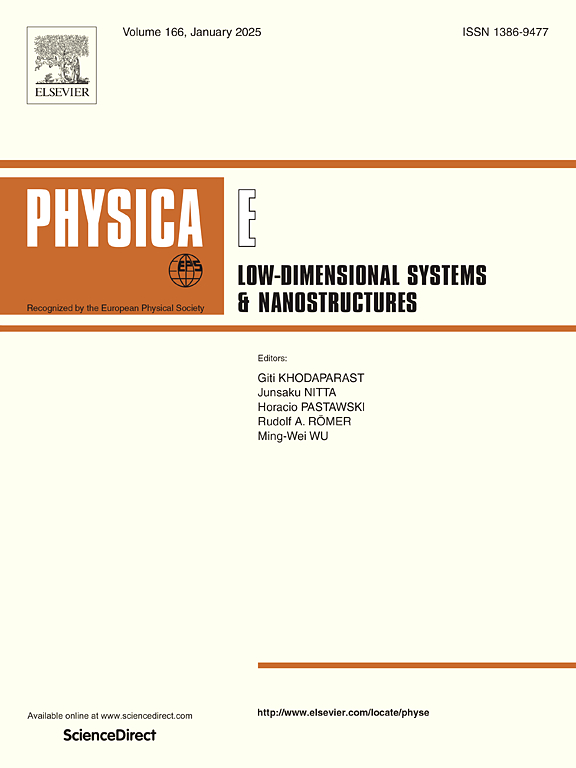The effect of nonlinear spin-orbit interaction on decay and recovery of 2D injected electrons spin polarization and velocity quantum oscillations
IF 2.9
3区 物理与天体物理
Q3 NANOSCIENCE & NANOTECHNOLOGY
Physica E-low-dimensional Systems & Nanostructures
Pub Date : 2025-05-21
DOI:10.1016/j.physe.2025.116286
引用次数: 0
Abstract
We have theoretically studied the dynamics of spin charged particles injected into a two-dimensional system with spin-orbit interaction in the presence of a perpendicular magnetic field, focusing on the role of the nonlinear part of the spin-orbit coupling. We showed that the spin polarization of these particles exhibits quantum oscillations, decay (collapses), and recovery (revivals), and can be effectively controlled due to the contribution from the nonlinear terms in the spin–orbit interaction. The presence of the nonlinear component of the spin-orbit coupling leads to more prominent oscillations in the particles’ spin polarization, resulting from the phase-locked motion of the particles, or to the emergence of chaotic behavior due to dephasing effects, depending on the system’s parameters. We have also analyzed the velocity dynamics of the charged particles and identified a beating regime when time intervals with constant velocity are alternated with time intervals of oscillating velocity amplitudes.
非线性自旋轨道相互作用对二维注入电子自旋极化和速度量子振荡衰减和恢复的影响
本文从理论上研究了自旋1/2带电粒子注入具有自旋-轨道相互作用的二维系统在垂直磁场作用下的动力学,重点研究了自旋-轨道耦合非线性部分的作用。我们发现这些粒子的自旋极化表现出量子振荡、衰变(坍缩)和恢复(恢复),并且由于自旋轨道相互作用中的非线性项的贡献可以有效地控制。自旋-轨道耦合的非线性分量的存在导致粒子自旋极化的振荡更加突出,这是由粒子的锁相运动引起的,或者是由于系统参数的减相效应导致的混沌行为的出现。我们还分析了带电粒子的速度动力学,并确定了恒定速度的时间间隔与振荡速度振幅的时间间隔交替时的跳动状态。
本文章由计算机程序翻译,如有差异,请以英文原文为准。
求助全文
约1分钟内获得全文
求助全文
来源期刊
CiteScore
7.30
自引率
6.10%
发文量
356
审稿时长
65 days
期刊介绍:
Physica E: Low-dimensional systems and nanostructures contains papers and invited review articles on the fundamental and applied aspects of physics in low-dimensional electron systems, in semiconductor heterostructures, oxide interfaces, quantum wells and superlattices, quantum wires and dots, novel quantum states of matter such as topological insulators, and Weyl semimetals.
Both theoretical and experimental contributions are invited. Topics suitable for publication in this journal include spin related phenomena, optical and transport properties, many-body effects, integer and fractional quantum Hall effects, quantum spin Hall effect, single electron effects and devices, Majorana fermions, and other novel phenomena.
Keywords:
• topological insulators/superconductors, majorana fermions, Wyel semimetals;
• quantum and neuromorphic computing/quantum information physics and devices based on low dimensional systems;
• layered superconductivity, low dimensional systems with superconducting proximity effect;
• 2D materials such as transition metal dichalcogenides;
• oxide heterostructures including ZnO, SrTiO3 etc;
• carbon nanostructures (graphene, carbon nanotubes, diamond NV center, etc.)
• quantum wells and superlattices;
• quantum Hall effect, quantum spin Hall effect, quantum anomalous Hall effect;
• optical- and phonons-related phenomena;
• magnetic-semiconductor structures;
• charge/spin-, magnon-, skyrmion-, Cooper pair- and majorana fermion- transport and tunneling;
• ultra-fast nonlinear optical phenomena;
• novel devices and applications (such as high performance sensor, solar cell, etc);
• novel growth and fabrication techniques for nanostructures

 求助内容:
求助内容: 应助结果提醒方式:
应助结果提醒方式:


